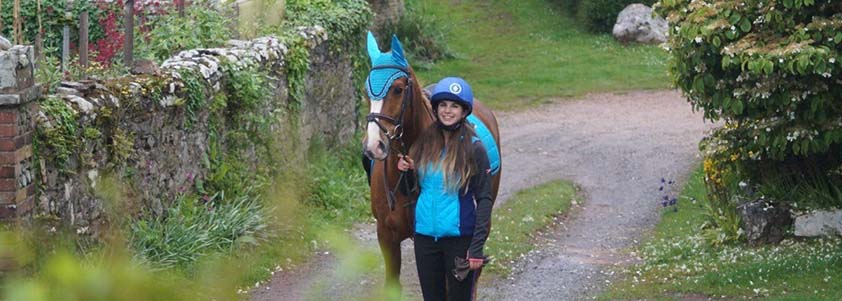
Young horses tend to make it very clear when they get bored, and by this I mean creating shapes that no mathematician has ever seen. Sprout was one of these, so I set up a series of exercises, both on the flat and over fences, each week to keep his mind occupied. I thought I’d share a few with you this month to keep your partners in top mental health. I have also attached the amount of poles and jumps needed for each exercise, so they can be tailored to your surroundings.
Weave Poles: 3 poles needed (Difficulty: EASY)
This is a great exercise to start off with, if your horse is feeling stiff, coming back into work, or tends to overheat! Set up 3 poles on the 3/4 line, parallel to the edge of the arena, and starting in walk, go over them in a small serpentine shape, one by one. This is a great exercise for accuracy also! You can target specific blocks of the poles to go over, and vary this to mix it up a bit.

Set Strides: 2 jumps needed (Difficulty: EASY/MODERATE)
This exercise is aimed at making your horse more adjustable. Set up a related distance of say 4/5 strides and just play around with your strides. If you have horse who likes to bowl on between fences, see if you can condense the canter and fit 6 strides in, likewise if you have a horse who tends to back off, see if you can make 4. Obviously don't be extreme, trying to fit 3 strides in a 6 stride line, keep safety in mind, but I find this one tends to make me focus on my riding as well, sitting up and keeping Sprout between hand and leg for a shorter stride, or riding him off the leg from landing to cover more ground!
Polework Pyramids : 3 poles needed (Difficulty: MODERATE)
There’s many things you can do with poles, but my favourite exercise is using them to improve rhythm. Only 3 poles are needed for this exercise, so it is easy to set up, but is handy to have somebody on the side adjusting for you! I start with a single pole going up the centre line over X, and trot a 20m circle over it. The aim is to keep your horse moving forwards so they do not “jump” the pole, simply make it another stride. Once the trot is established, you can repeat at a canter, if your horse is more advanced, you can add in flying changes or changes of rein to mix it up a bit. Once the canter is conquered, add in a second pole, to make it slightly wider (you may find you need a bigger canter to avoid the “hop”). Again, after you are comfortable with this, a third pole can be added on top of the other two (creating a pyramid) which is the most challenging, the horse needing to keep its rhythm even with the added height. By regulating the pace evenly, and making sure your horse doesn't focus on the poles, you should find your quality of canter improves, as well as your striding into a fence.
Bending Lines: 5 jumps needed (Difficulty: HARD)
If you have the space and equipment, this is a brilliant exercise to stretch both sides of the body and keep your horse together, as well as practising abnormal angles! Set up 5 jumps going up the centre line next to each other (or at 45 degrees to each other, creating a zig-zag pattern- both are good variations), and weave over them. To start with I’d advise using the first and fourth jumps (or equivalent) until your horse is in the right mind-frame. Start coming off a diagonal over the first, then do an inverted shallow loop back over the fourth. As the session progresses, you can try the first, third and fifth, or even try going over the first, collecting through a 1/2 10m circle, then back over the second! Tailor your courses to both your own and your horses expertise. This is a complex exercise so there’s no point trying something risky and losing confidence!
I know how hard it can be to be in an area with no arena, but there are many ways you can jump without, such as seeing if there are any riders or yards local to you that have an arena you can use, even if it is for a small fee, or finding natural jumps when out hacking (make sure they are safe to jump first!). By utilising the space around you, you can not only improve your confidence, but work on aspects of flatwork such as straightness or rhythm on roads, following the edge of the road, or practising a leg yield along a lane so long as it is safe! Everything is do-able without an arena, you just need to use your imagination!
